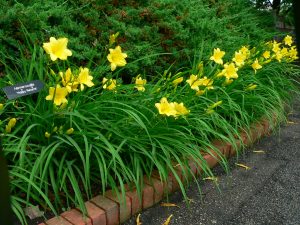Choosing weather tolerant plants
July 12, 2023
Daylilies are an example of a common home garden plant that is able to store relatively large amounts of water and therefore tolerant dry spells. (Photo courtesy of University of Minnesota)
Weather extremes have long been part of midwestern weather. But growing awareness that climate change could cause normal variations to become more extreme has many gardeners exploring ways to create weather-tolerant landscapes that can adapt to both drought and occasional flooding.
Start with the Soil
While Illinois rainfall ranges from 30 to 50 inches a year, it rarely falls evenly during the growing season. Instead of the roughly 1 inch of rain a week that many nonnative ornamental plants need, drenching rains are often followed by long spells of bone-dry weather.
Easy steps that help plants to survive both heavy rainfall and drought begin with the soil. Adding partially decomposed organic matter will improve most any kind of soil. Heavy clay soils drain better, allowing moisture to penetrate deeper. And the very same organic matter makes it easier for naturally fast-draining sandy soils to retain more life-sustaining moisture.
Adding a layer of organic mulch on top of the soil reduces evaporation and keeps fast-growing weeds from winning the battle for scarce moisture. But mulch also makes it less likely that rain-saturated soils will become compacted, a serious threat to long-term plant health.
When rainfall is scarce, irrigating deeply but infrequently encourages plants to develop extensive root systems capable of finding every available drop of moisture. But extensive roots also help plants to take full advantage of drenching storms. One inch of water delivered at one time penetrates the top 4 to 5 inches of clay soil, and up to 12 inches in sand. In between deep waterings—natural or supplemental—as soils become dry, roots resume growing in search of life-sustaining moisture. Constantly sprinkled plants become spoiled, and develop shallow root systems that leave them less able oR even unable to sustain themselves during drought.
Choose Plants Carefully
Perhaps the best way to have a weather-tolerant landscape is by selecting plants with a natural ability to survive both drought and drenching storms. Midwestern native plants have already adapted to these challenges, and have a head start for adapting to greater extremes.
Many herbs such as Berggarten sage produce a protective haze that protects leaves from drying out in hot summer sun. For both native and nonnative plants, there are leaf characteristics that make it easier for some plants to withstand drought:
- Silvery, gray, or whitish leaves tend to be more drought resistant.
- Hairy leaves are able to collect or trap moisture.
- Plants with divided leaves have less leaf surface from which to lose water.
- Thick succulent leaves can store water.
- Aromatic leaves of herbs create a protective haze that helps them to avoid drying out during the heat of the day.
Not surprisingly, roots are also important for determining whether a plant is drought tolerant. Plants with thick fleshy roots, such as daylilies, are able to store relatively large amounts of water, and those with taproots can find deeper water sources.
But deep-rooted plants are also valuable during spells of heavy rains. Blue false indigo (Baptisia australis), a midwestern native, has roots that can go down 25 feet. These deep, fleshy roots create channels that allow drenching rains to soak deep into soil.
Through drought or flood, there are beautiful, long-lived plants that will shine through the challenges of every season.
(SOURCE: Chicago Botanic Garden)







